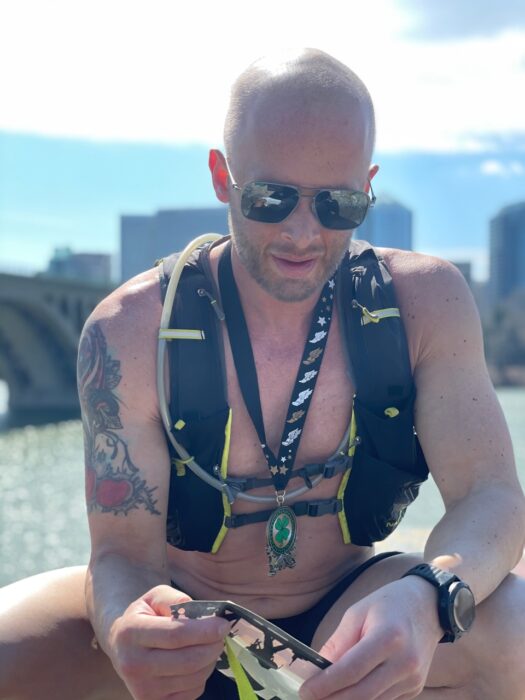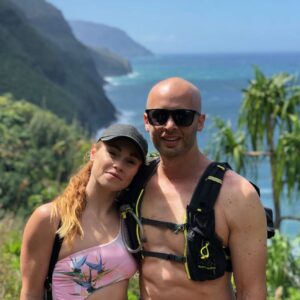(Adam Viccaro recently shared his inspirational story of how he prepared and reached his goal to run a marathon, despite not being able to sweat due to hypohidrotic ectodermal dysplasia (HED). Following is the second part to his story. Adam gives his best tips for how to prepare for and live your best sweat-free life.)
By Adam Viccaro
Rule #1: Believe You Can Do Anything
As one of my good friends put it, “I think not being able to sweat is actually a superpower. You’ll perform better than anyone else in a cold climate. Imagine the advantage you’d have climbing Mt Everest!”.
I start with the mind because your mindset is the foundation for everything. It’s what makes you believe you can, and in those tough moments, your mental strength will help you get through any challenge. Your mind will give up well before your body says it’s had enough.
Now, before I go any further, I need to share a word of caution: Your body does have real limits, and as someone who can’t sweat, you have different limits than everyone else. Developing mental toughness will help you find your limits, and push your limits. But, as someone who is sweat-free, when it comes to overheating, listen very closely to your body. If I want to go for a run on a sunny 80-degree day, I’m going to have a bad time no matter how bad I want to run.
Rule #2: Know Your “Heat Limit” and Learn How to Increase It
Every body has a limit. However, many people tend to accept their first limiting experience as their limit forever. What I’ve found is that this limit actually shifts depending on how prepared your body is. For example, if I try to do yard work on the first hot spring day, I won’t be able to last as long in the heat as I would later in the summer. My body adapts to the heat through increased exposure, and with that adaptation comes the ability to withstand higher temperatures.
When I’m training (in a safe environment), I will frequently challenge myself by doing something strenuous in the heat for short bouts. I’ll allow myself to get hot, then take a break to cool off. After repeating that a few times, and doing it on a regular basis, I can actually raise my “heat limit” over time.
Doing this will also teach you the compounding effect that overheating has on the body. Once the cycle of over exposure begins and you start overheating, things can spiral out of control very quickly.
What Gets Measured Gets Managed
A good way to think of this is to imagine your body has a limit of 100 points it can handle before overheating. As soon as you reach that limit, you get heat stroke, a very dangerous condition.
Let’s imagine a scenario where we are out in 80-degree full sun for 15 minutes. Walking might add one point every minute bringing your score to 15. Running would probably add five points every minute, giving you a score of 75 (close to your limit). Now, let’s say dumping cool water on yourself removes one point per minute. If you were to cool off for 15 minutes after walking, you’d be back to normal. If you cool off the same way after running, you still have a score of 60. Even if you tried to walk in the heat for 15 minutes after that, you’d be back in the danger zone very quickly.
“What gets measured gets managed.”
Rule #3: Prepare For the Conditions
Related to knowing your “heat limit” is understanding the different variables at play. A cloudy 70-degree day is different than a sunny 70-degree day. A cool breeze can help or hurt depending on which way it’s blowing. Running hills pushes you closer to your “heat limit” much faster than running on the flats. All of these are examples of factors I consider every time I work out.
For myself, I know that if I’m going to run more than five miles, the temps need to be no higher than 60 degrees if it’s cloudy. If it’s sunny, low 40s or colder is the sweet spot. If I’m running up a mountain, I need it to be in the 30s. Anything above those temperatures and I need to slow my pace and refill my water pack with ice more often.
When I ran my marathon in 2021, the starting temp was around 45 degrees, a good seven degrees warmer than forecast. On top of that, the late March sun was shining strong in my face for half of the race. With the wind at my back, it felt like there was no wind at all. I started the race running 8-minute miles. However by mile 10, I was running a 12-minute pace and contemplating bailing at the halfway point.
Knowing my heat limit in these conditions, I should have started slower to limit the compounding effect of the heat. I also should have planned to have more ice throughout the race. Fortunately, I had the support of my wonderful girlfriend, Ashleigh, who walked a mile with a cooler of ice to give me a refill, getting me across the finish line. My time was much slower than I wanted, but I finished the race, which is all that mattered.
Rule #4: Avoid Dangerous Situations, and Plan for The Worst.
Having a cooling strategy is a must for every sweat-free individual. This isn’t just a workout thing either—you need to have a way to cool off in an emergency. Preparation is the key to all victories, and when your life’s on the line, you need to be ready.

I’ll give one example to illustrate how quickly things can go south. This only happened a few years ago, and despite knowing better, reality is that we all make mistakes. Sometimes those mistakes have a razor thin margin for error, which is why I think it’s important to always have an emergency plan ready. Not only should you have a plan, but the people with you need to know the plan as well. If you’ve ever overheated, or been with someone who is overheating, you know that you can’t always think straight, and desperation can lead to dangerous decisions.
The Unforgiving Desert
The situation I went through involved a friend’s wedding in San Diego. Not the tropical beaches of San Diego you might be thinking of, but the unforgiving desert that exists only a few miles inland from the coast. The wedding was late summer and far inland, deep into the heat of the desert. Temperatures are normally in the 80s/90s at that time of year. However, this year there was a heat wave, and temps were forecast to be above 100. I didn’t think too much of it because I assumed the wedding would be indoors, or would have an indoor space where I could hang out.
Come the day of the wedding, the temperature was a scorching 115 degrees by midday. No worries, I said to myself, they’ll have A/C and ice—I could use a cold drink! We arrive at the vineyard, and our Uber’s A/C was struggling to keep the packed car cool. I walked in and immediately looked for a place to cool off. Nothing. A/C wasn’t working. Ice maker wouldn’t produce a cube of ice. There was nowhere to go, stuck in the middle of the desert. Emergency mode on.
I called an Uber to get out of there and found the coolest place I could, dumping warm water on myself to cool. My Uber arrived after 10-15 minutes, and I jumped in hoping for some relief. Turns out the driver’s car was old and also struggling to cool itself, never mind pumping A/C. So there I was, not sweating, overheating, and driving through 115 degrees in the desert in a car that may not make it over the next hill. If you can’t sweat, you probably feel anxiety just reading this story. It’s a situation you never want to be in, and I share it as a lesson to never let your guard down.
Scary moments aside, all of us who are sweat-free all learn to live with the heat. Some of us live in hot climates, some in cooler climates, but we all have our moments and struggles with this unique challenge. Learn how to manage the heat and adapt to it, and you’ll be able to unlock experiences that today you think are impossible and live your best seat-free life!

Love this story. I live in bakersfield California and it’s very hot in summer. It’s true after time my limits get better.